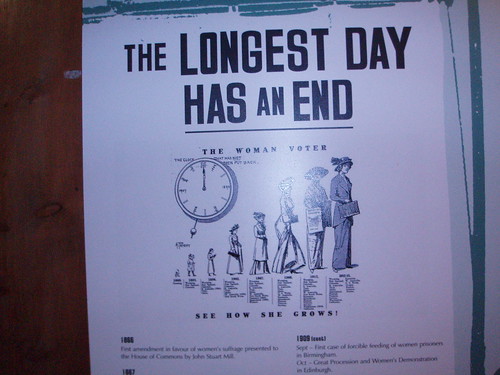At the Museum of Edinburgh is an exhibition commemorating the women's suffrage campaigns in the UK.
There was this interesting poster there:

The poster has the slogan "The longest day has an end" prominently at the top. Below that on the left is a clock set to midnight. Below that, and rising to the right of the clock, is a timeline running from 1869 to 1913, detailing the countries and sub-national regions that allowed at least some women to vote, graphically illustrated by sketches of a woman growing older and taller from a tiny baby (waving a flag) in 1869 to a full-height woman in 1913.
Reformatted for the web, here's the timeline:
| Year | Countries/Regions with at least some women allowed to vote |
|---|---|
| 1869 | Wyoming |
| 1893 | Wyoming, New Zealand, Colorado |
| 1896 | Wyoming, New Zealand, Colorado, S. Australia, Utah, Idaho |
| 1902 | Wyoming, New Zealand, Colorado, S. Australia, Utah, Idaho, W. Australia, New South Wales |
| 1907 | Wyoming, New Zealand, Colorado, S. Australia, Utah, Idaho, W. Australia, New South Wales, Tasmania, Queensland, Finland |
| 1908 | Wyoming, New Zealand, Colorado, S. Australia, Utah, Idaho, W. Australia, New South Wales, Tasmania, Queensland, Finland, Victoria, Norway |
| 1911 | Wyoming, New Zealand, Colorado, S. Australia, Utah, Idaho, W. Australia, New South Wales, Tasmania, Queensland, Finland, Victoria, Norway, Washington, California |
| 1912-1913 | Wyoming, New Zealand, Colorado, S. Australia, Utah, Idaho, W. Australia, New South Wales, Tasmania, Queensland, Finland, Victoria, Norway, Washington, California, Oregon, Kansas, Arizona, Alaska |
Below the timeline is the second slogan "See how she grows!"
The whole exhibition - if you happen to be able to get there before it closes, and find it in the museum (accessibility is not universal) - is worth seeing.
One of the points being made by the timeline is that no area that granted women the right to vote had since revoked it, and I think this point provides a useful division of social justice issues.
For some issues, like suffrage, or the right of LGB people to serve in the military, there is a clear point. It may take decades or centuries of difficult struggle to argue up to that point, but once there the gains are relatively safe - once the critical threshold has been passed in a particular democratic jurisdiction, the idea fairly rapidly passes into general acceptance, to the extent that even those who opposed it before move to support it, at least in public.
The gains are reversible - any violent or otherwise sudden overthrow of the system of government, from within or without, might reverse them - and that they're otherwise unlikely to be reversed of course doesn't imply that there doesn't remain a significant minority of people who believe that they're nevertheless wrong. There are still people in the UK who believe that women shouldn't have the right to vote.
For other issues, there's no such critical threshold. The level of rights available can go backwards and forwards across a wide range over the decades, as different opinions gain and lose dominance in governments and in the wider population. Access to abortion has changed back and forth quite a bit in many countries. It's still, just about, a fringe view in the UK Parliament that it should be outlawed entirely - but of course that's a fringe that will grow as erosions are made to the existing rights. Attitudes - and legislation - towards immigration has also varied back and forth a lot. Any gain made with this sort of issue needs to be heavily defended just to make it into a new baseline against the counter-attempts of privilege.
What's not at all clear to me is why an issue falls into one or other type. It's not just about it being a binary divide or not - in the UK women's suffrage proceeded in stages, while the binary issue of defendant anonymity in rape cases has changed back and forth and remains contentious today.
It's also not, as far as I can tell, about differentials between public opinion and government opinion. Sometimes the government lags far behind public opinion on the matter - as the UK government is doing on same-sex marriage - and sometimes it introduces legislation that leads the way and public opinion follows (as happened with the abolition of the death penalty).
It seems like it would be useful to know why some successes stick and others don't, and perhaps how a success could be made to stick when it otherwise wouldn't, but I don't know of much that's been said on that.